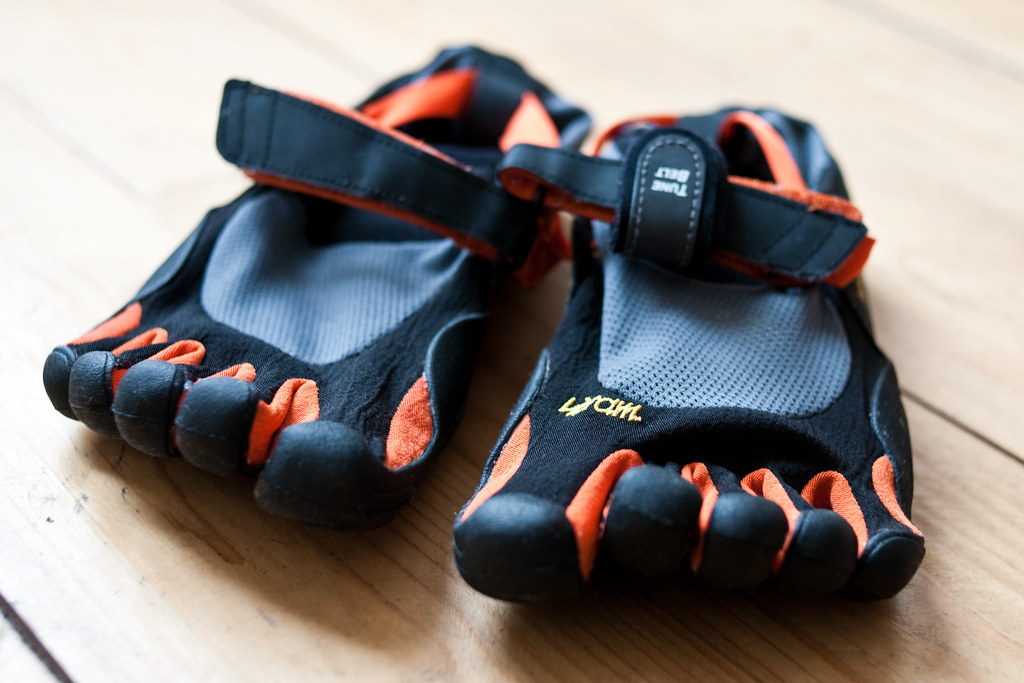Could barefoot running be the key to running on concrete safely?
Due to the improved technique and gait offered by running barefoot, this could be the case.
This could be your chance to separate yourself from the 50% of runners who suffer from injury each year!

All You Need To Know About Barefoot Running On Concrete:
Barefoot running on concrete can:
- Improve running form
- Reduce the risk of injury
- Improve muscle & joint health.
However, if correct form is not used it can increase stress on your joints, leading to injury.
Equally, if you do not follow a correct transition, this will also lead to pain and injury.
We will start with the benefits and drawbacks of running barefoot on concrete, before looking at 4 great tips, and then finally getting some insight from experienced barefoot runners.
What Are The Benefits Of Barefoot Running On Concrete?
Minimalist running on concrete surfaces has both benefits and drawbacks.
Here are some of the positive effects it can have:
Positive Effects On Gait
We naturally improve our gait when wearing minimalist footwear, or going completely barefoot.
This is because we adapt a forefoot strike when our heel and toes are on the same level..

You can consciously achieve a forefoot strike by aiming to land gently on the balls of your feet instead of your heels.
This technique allows your calf muscles and arches to act as natural shock absorbers, reducing the impact on your knees and hips.
Improved Posture
Barefoot runners tend to develop a more upright posture, which becomes easier to adopt WITHOUT the support of shoes.
Correct posture involves:
- Proper head position (gaze forward and avoid tilting your head down)
- Shoulder alignment (imagine you’re holding an apple between your shoulder blades to maintain correct shoulder alignement)
- Straight back (engage your spine to remain upright)
- Tight core (always keep your core engaged to support and upright position)

Try and keep your center of gravity balanced above your knees and hips and avoid overstriding.
This proper alignment helps to reduce the strain on the spine and knees, leading to fewer injuries and less discomfort.
Reduced Risk Of Injury
Transitioning to barefoot running can have a positive impact on injury prevention.
When done correctly, barefoot running encourages a forefoot strike pattern (as discussed previously), which helps reduce the risk of injuries associated with heel-strike running.
These include:
- plantar fasciitis
- runners knee
- hip injuries

Furthermore, running without shoes provides an opportunity to build strength in the feet and lower legs, which can contribute to an overall reduced risk of injuries.
Improved Muscle and Joint Health
Running barefoot on concrete can help to strengthen the muscles in the feet and lower legs.
Without the cushioning and support of traditional running shoes, the body is forced to rely on its natural shock-absorbing mechanisms (mainly your arches and calves).
This engages and strengthens your muscles and joints, notably the calves, achilles and ankles, making them more resilient and adaptive.
I covered the benefits of barefoot running on concrete in more details in this article:
Potential Drawbacks From Barefoot Running On Concrete
Stress on Joints
Concrete is probably the hardest surface you will run on (10 times harder than asphalt!).
It is a widespread concern that running on hard surfaces increases stress on your joints.
However, recent studies [1] suggest that the running surface makes little difference to how much stress is placed on our legs whilst running.
Instead it is our running technique which often causes injury.
The ‘Muscle Tuning’ Concept
First proposed in 2001, ‘muscle tuning’ is a dynamic process that involves the activation of specific muscle groups in response to the demands of the task at hand.
Translated into running terms, your leg muscles adapt to the surface you are running on.
For example, if you run on a soft surface, such as grass, your muscles will stiffen before hitting the ground.
Likewise, running on hard surfaces like concrete, makes your muscles contract with less force.
The concept of ‘muscle tuning’ means that there is little to no difference on the impact your leg suffers on hard and soft surfaces.
An experiment published in the National Library of Medicine, showed that when transitioning from a soft to hard surface, leg stiffness decreased by 29% [1].
This concept means that runners should be more focused on perfecting their technique than the surface they’re running on.
Cuts, Grazes And Surface Injuries
The most obvious risk with completely barefoot running is surface injuries (grazes, cuts, splinters, etc…).
You should always scan your path for potentially dangerous items (glass, debris).
There are two solutions for this problem:
1. Running Location
Another thing to consider is planning where you go running.
Certain locations, such as rubber running tracks and grass sports fields would be ideal in most cases.
I cover the best places to go barefoot running in detail in this article:
2. Minimalist footwear
These special shoes are ideal as they protect your feet from surface injuries without taking away from the barefoot running experience.
I cover this in more detail just below.
Here Are 4 Top Tips For Barefoot Running on Concrete
1. Consider Wearing Minimalist Shoes
When running on concrete, you should consider barefoot shoes.
Also known as minimalist footwear, these special shoes protect your feet, whilst replicating a barefoot running experience.
They are defined by the following characteristics:
| Characteristic | Purpose |
|---|---|
| Low Heel Drop (0-4mm) | Promotes a forefoot strike. |
| Minimal/no Arch Support | Strengthens feet |
| Wide Toe Box | Allows toes to spread naturally, improving balance |
| Thin Sole (3-5mm) | Improves ground feel |
| Flexible | Allows feet to flex and move freely |
2. Transition Gradually
I speak about the importance of a proper transition in many of my articles, but I’ll say it again:
A CORRECT TRANSITION IS KEY!
If you remove all artificial support from your feet in one go, you could cause serious pain and discomfort.
Start off by simply going barefoot (or in barefoot shoes) around the house, before venturing out for short walks. When you feel comfortable you can try short runs.
Gradually increase the duration and frequency of your barefoot runs, and make sure each pair of minimalist shoes you buy has a little less arch support.
It can take up-to a year for some people to fully transition, so don’t rush!
3. Ensure Proper Foot Care
Never forget proper foot care, especially when running completely unshod.
Be mindful of the running environment and avoid hazards like glass and debris that may cause injuries.
Regularly inspect your feet for:
- cuts
- blisters
- bruises
Make sure you allow time for any of these to heal before continuing your barefoot running sessions.
4. Work On Your Technique
Using the correct barefoot running technique can help reduce the impact on your foot and leg and improve running efficiency.
The main things to work on are your:
- Posture
- Foot Strike
- Cadence/Stride Length
I have already spoken about posture and foot strike in some detail above, so here’s what you need to know about cadence and stride length:
Stride length refers to the distance traveled by each stride, while stride frequency (or cadence) denotes the number of strides taken per second.
Without the cushioning offered by traditional running shoes, barefoot runners are more likely to adopt shorter, quicker strides.
This results in a higher cadence which is often associated with a more efficient running form and reduced risk of injury.
An estimated 60-70% of runners overstride according to Auptimo [2], which can lead to shin, knee, and hip injuries.
To summarize, adopt a forefoot strike instead of a heel strike, maintain proper posture with a slight forward lean and keep your knees slightly bent, and finally, focus on a higher cadence with shorter strides, which will reduce the impact forces on your body.
This article will help you with your running technique and some other useful points for barefoot running:
What Do Experienced Barefoot Runners Say? (Reddit)
In this thread from the renowned BarefootRunning community on reddit, a user asked if he could play basketball barefoot on concrete to help him with his patelaar tendonitis.
Although not completely relevant to the topic, some of the insights from experienced barefoot enthusiasts were great, so I’ve decided to include some below.
This comment sums up perfectly what you need to know about barefoot running:
When you’re barefoot, you can’t land on your heel. It hurts. So you run up on the ball of your foot all the time and your heel either does not hit, or you lay it down after the impact.
When done like this, your Achilles and calf act as a big shock absorber. You bounce.
You can’t just switch over. It takes time running this way for your calves to build up. If you run a kilometer barefoot, your Achilles and calves are going to hurt a lot the next day.
Concrete, asphalt or dirt really don’t make a difference. The shock absorption is from your foot.
User: bonzai2010
Another reassuring comment from this extremely experienced barefoot runner (40-50 km a week) suggests that the surface you’re running on makes little difference if you have perfected your technique.
This backs up the concept of muscle tuning that we saw earlier.
I run around 40-50km [25-31 miles] a week barefoot on concrete. It’s an easy running surface. The hardness does not seem to cause a problem.
Barefootblues42
Conclusion
In summary, running barefoot on concrete can benefit runners who adopt the right technique and who follow a correct transition.
Barefoot running on concrete helps develop stronger withdrawal reflexes in the feet, enhances joint position sense, and improves forefoot strike landing precision.
Remember that a sudden transition to barefoot running on concrete is a recipe for disaster!
All in all, with the right approach, minimalist running on concrete can be advantageous. However you should consider personal factors and proceed with caution.
Sources
- Runners adjust leg stiffness for their first step on a new running surface – National Library of Medicine
- Analyzing The Gait Of Injured Runners: Overstriding – Auptimo
- Running Barefoot On Concrete, Is It Safe? – Reddit
FAQs
Q: Is barefoot running on concrete safe?
A: Barefoot running on concrete can increase stress on joints due to the lack of cushioning, but it can also encourage a more efficient and natural gait. It is important to gradually transition and listen to your body to avoid injuries or discomfort.
Q: Can barefoot running on concrete improve running form?
A: Yes, barefoot running on concrete can improve running form by promoting a forefoot strike and reducing the tendency to heel strike, which is common in runners who wear cushioned shoes. It can also strengthen the ligaments, bones, and muscles in the feet.
Q: What are the benefits of barefoot running on concrete?
A: Barefoot running on concrete can help develop stronger withdrawal reflexes in the feet, improve joint position sense, and enhance forefoot strike landing precision. It can also transform the feet into more efficient energy-saving springs, which could be beneficial even when running with shoes.
Q: What are the risks of barefoot running on concrete?
A: Barefoot running on concrete can increase stress on joints and increase the risk of injuries like cuts, blisters, and bruises. It is important to gradually transition and maintain proper foot care to avoid injuries or discomfort.
Q: Should I start barefoot running on concrete right away?
A: No, it is important to gradually transition and start on softer surfaces like grass or sand before incorporating concrete surfaces. It is also advisable to consult a medical professional before significantly changing your running habits.


